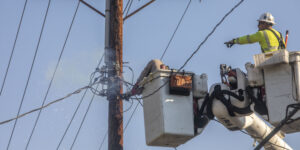Almost 25 years have passed since a Category 5 hurricane struck south of Miami, and the city’s vulnerability to catastrophic storm damage has grown exponentially, according to a new insurance underwriters’ analysis.
At the time, Hurricane Andrew was the most expensive natural disaster in U.S. history, causing more than $26 billion of damage in Florida’s most populous areas, including $15.5 billion in insurance payouts. Stringent building code enforcement followed in Miami, but so did population growth, coastal development and climate change.
“Our concerns lie with the fact that even though we’ve made good changes, 25 years later you have a much larger population living in Florida, and people forget what can happen or they don’t know what could happen,” said Monica Ningen, chief property underwriter for the U.S. and Canada at Swiss Re.
The Switzerland-based reinsurance company released an analysis Wednesday estimating the losses if a hurricane similar to Andrew’s size and strength hit Miami and its suburbs today.
Catastrophic Losses
On Aug. 24, 1992, Andrew blasted ashore about 20 miles southwest of Miami with winds topping 165 mph. The hurricane killed 15 people and indirectly caused the deaths of 25 more in Miami-Dade County alone, according to the National Hurricane Center.
Andrew destroyed 25,524 homes and damaged another 101,241; nearly all the mobile homes in its path were completely lost.
If a similar hurricane barreled down the same track today, Swiss Re estimates damage would range from $80 billion to $100 billion, including up to $60 billion in insured losses.
Should a similar hurricane target Miami directly, Swiss Re estimates unprecedented losses: $100 billion to $300 billion, including insured losses up to $180 billion.
Storm Surge
For all the extreme conditions Andrew produced, storm surge flooding from the compact hurricane was relatively minor in Florida. The abnormal rise of sea levels, driven ashore by storm winds, can be a hurricane’s most deadly hazard, but no one died because of Andrew’s storm surge – a fact the hurricane center considered “a fortunate aberration.”
According to hurricane center records, only $96 million in federal flood claims were reported after Andrew.
Rising sea levels caused by climate change is expected to exacerbate storm surge flooding. Even a moderate rise of 3.5 inches by the 2030s could increase storm-surge-related losses along South Florida’s coastline to roughly $11 billion, said Megan Linkin, a meteorologist and natural hazards expert at Swiss Re.
That’s particularly troubling because even a tropical storm can cause major coastal flooding.
For example, Sandy’s enormous size drove catastrophic storm surge onto the New Jersey and New York coastlines even though the storm weakened and lost its tropical characteristics before making landfall in October 2012. Causing more than $50 billion in losses, Sandy now ranks as the second most costly hurricane to hit the U.S., ahead of Andrew and surpassed by only Hurricane Katrina.
Protection Gaps
Swiss Re now estimates the combined residential values in three Miami-area counties are roughly $660 billion and commercial values are about $550 billion.
Insuring those properties can be expensive and difficult in Florida. Only 19 percent of the state’s homeowners have flood insurance. Many insurers stopped renewing homeowner policies after eight hurricanes hit the state in 2004 and 2005, forcing property owners into the state-managed insurance company created 10 years after Andrew, which lawmakers intended to act as Florida’s insurer of last resort.
That company, Citizens Property Insurance, now has more than 451,000 customers statewide who face rate increases that officials say are needed to cover rising costs associated with water damage claims not related to tropical storms or hurricanes.
Ningen advises homeowners and elected officials to focus on closing protection gaps by exploring new insurance products that can help cover losses, upgrading existing structures through the Insurance Institute for Business & Home Safety’s “Fortified Home” program, heeding new hurricane center advisories setting deadlines for completing storm preparedness and supporting infrastructure projects such as the installation of a $400 million system of stormwater pumps in Miami Beach.
“To us, resiliency does not mean waiting for the federal government to bail you out,” she said. “It’s what you can do, and local governments stepping in to do what they can do.”





















 Mercury General Wildfire Losses Will Hit Reinsurance Cover. One Event?
Mercury General Wildfire Losses Will Hit Reinsurance Cover. One Event?  Auto Insurer Files $450M Fraud RICO Case in NY
Auto Insurer Files $450M Fraud RICO Case in NY  Andrade Leaving Everest for USAA; Williamson Named Acting CEO
Andrade Leaving Everest for USAA; Williamson Named Acting CEO  California Wildfires Will Likely Lead to Large Economic and Insured Losses
California Wildfires Will Likely Lead to Large Economic and Insured Losses 










